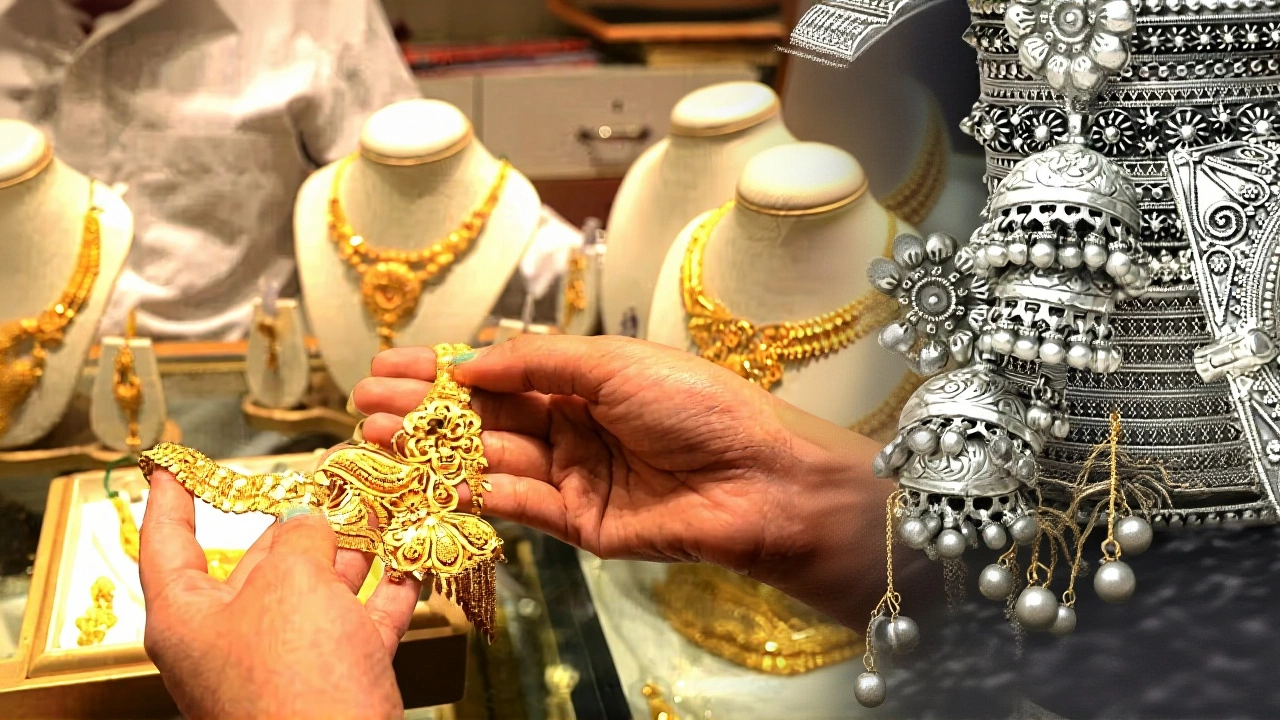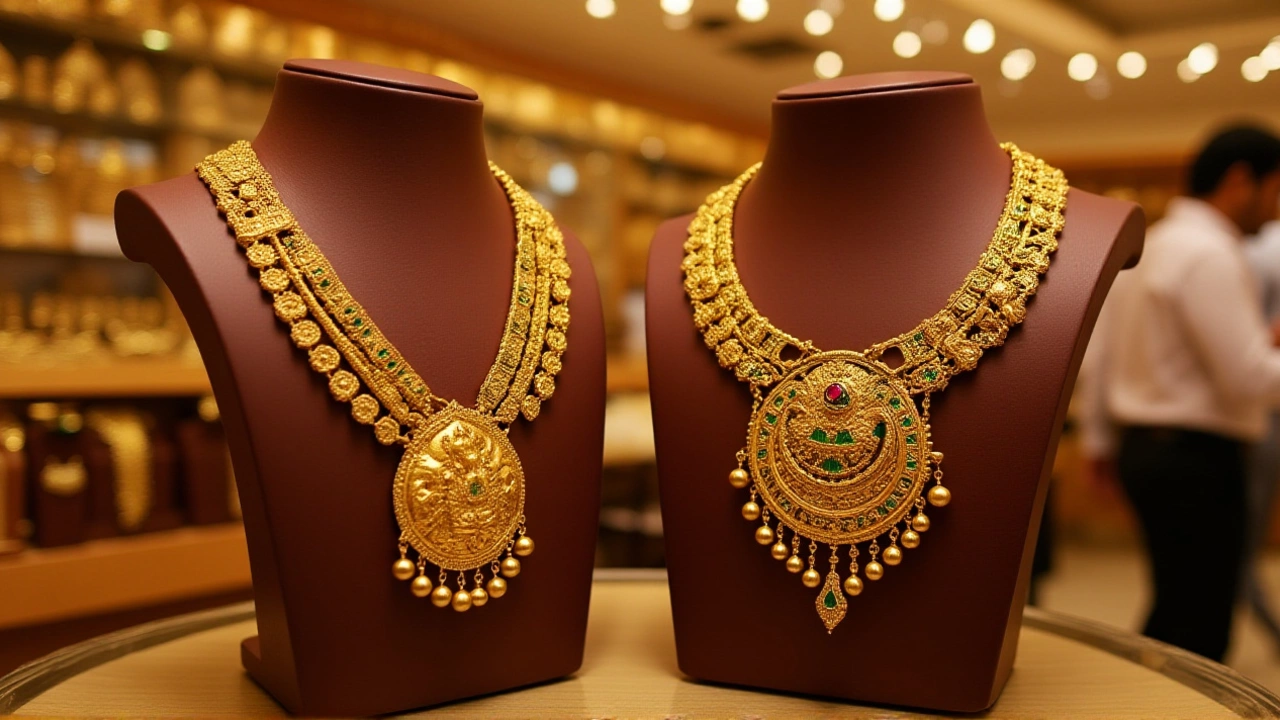India’s gold price surged to a fresh record on Dhanteras 2025, hitting ₹1.34 Lakh per 10 g in Delhi’s bustling sarafa market, while other hubs posted similarly lofty numbers. The jump, driven by festive buying, central‑bank purchases and a flood of ETF inflows, has analysts whispering about an even steeper climb heading into 2026.
Historical Context: How We Got Here
From the start of 2022 to October 2025, gold in India has climbed roughly 140 % – a pace few commodities have matched. According to a recent report by Moneycontrol, the metal’s price has already risen about 50 % this year alone, outpacing most equity indices.
Several macro forces are at play. Global inflation pressures have kept central banks on high‑alert, while lingering supply‑chain snags in mining regions have tightened physical delivery. Add a robust domestic demand spike during the Diwali season, and the market finds itself in a perfect storm.
Current Gold Price Surge: Numbers that Matter
On the morning of 18 October 2025, the India Bullion and Jewellery Association (IBJA) quoted 24‑carat gold at ₹1,30,874 per 10 g – a jump of ₹3,627 from the previous day. Meanwhile, the Multi Commodity Exchange (MCX) listed the same purity at ₹1,25,957, a modest ₹312 rise.
Delhi’s iconic sarafa market, a traditional gold‑trading hub, recorded a peak of ₹1,34,800 per 10 g, according to the All‑India Sarafa Union. In the same session, 99.5 % purity gold rose to ₹1,34,200, marking the highest tax‑inclusive price in the city’s recent history.
- IBJA (24‑carat) – ₹1,30,874/10 g
- MCX (24‑carat) – ₹1,25,957/10 g
- Delhi Sarafa (99.5 % purity) – ₹1,34,200/10 g
- Tanisk (22‑carat) – ₹12,210 per gram (≈₹1,22,100/10 g)
These figures place the metal well above the ₹1.20 Lakh–₹1.30 Lakh range that analysts had penciled in for the festival.
Market Reactions on Dhanteras
Retail jewelers across the capital reported a flood of customers, with brands like Tanisk and Klayon seeing queues that stretched beyond their storefronts. The day’s trade volume in Delhi’s sarafa market was up roughly 18 % compared with the previous Thursday, according to the union’s daily bulletin.
Interestingly, as gold prices surged, silver slipped. The same union noted a ₹7,000 drop in silver rates, underscoring investors’ shift toward the perceived safety of gold during the festive rush.
Central banks have also been active. Reserve Bank of India’s recent open‑market purchases, combined with heightened inflows into gold‑backed Exchange‑Traded Funds (ETFs), added a layer of institutional demand that bolstered the rally.
Expert Opinions: Why the Rally May Not End Yet
"We’re seeing a classic supply‑and‑demand mismatch amplified by festive buying," says Ramesh Kumar, senior commodity analyst at Bloomberg. "Global monetary policy is still accommodative in many economies, and that translates into higher gold inflows via ETFs. Couple that with the Indian market’s seasonal peak, and you’ve got a recipe for continued upside."
Another voice, Dr. Anita Desai, professor of economics at Delhi University, adds, "If inflation stays sticky, central banks may keep buying gold as a hedge, which could push prices toward the ₹1.5 Lakh mark by early 2026. The key variables will be USD strength and Indian rupee stability."
Both experts agree that the current rally is unlikely to fizzle out before the next major Indian festival cycle, which typically begins with Holi in March.

Outlook for 2026: Projections and Risks
Moneycontrol’s analysts forecast that gold could breach the ₹1.5 Lakh threshold per 10 g by the start of 2026 if the prevailing trends hold. The projection rests on three pillars:
- Continued central‑bank accumulation, especially as reserves are diversifying away from fiat currencies.
- Steady ETF inflows driven by global investors seeking safe‑haven assets.
- Seasonal demand spikes during Diwali, Dhanteras, and later festivals.
Risks, however, loom. A sharp appreciation of the US dollar, a sudden easing of global inflation, or a major supply shock that releases new gold reserves could temper the ascent. For now, market sentiment remains bullish.
Key Takeaways
- Gold reached a record ₹1.34 Lakh per 10 g in Delhi’s sarafa market on Dhanteras 2025.
- IBJA and MCX reported similar record‑high prices, confirming a market‑wide surge.
- Central‑bank purchases and ETF inflows are reinforcing the rally.
- Experts anticipate prices could climb to ₹1.5 Lakh per 10 g by early 2026.
- Silver prices fell by about ₹7,000, reflecting a shift toward gold.
Frequently Asked Questions
How does the current gold price affect Indian jewellery buyers?
Higher gold rates mean larger upfront costs for consumers, especially during festival season when demand peaks. Retailers may offer more financing options or discounts on lower‑purity items to keep sales volumes steady.
What role do central banks play in the gold rally?
Central banks buy gold to diversify reserves and hedge against currency volatility. Their purchases add institutional demand, which, combined with retail buying, pushes prices upward.
Why did silver prices drop while gold surged?
Investors often view silver as a more volatile counterpart to gold. When gold’s safe‑haven appeal intensifies—especially around festivals—capital flows shift from silver to gold, causing the former’s price to slide.
What could cause the gold price to fall after reaching record highs?
A rapid strengthening of the US dollar, easing global inflation, or a sudden increase in gold mining output could dampen demand and pull prices down.
When is the next major price test expected for gold in India?
Analysts point to the Holi festival period in March 2026 as the next seasonal catalyst, when buying typically spikes again, potentially testing the ₹1.5 Lakh threshold.
